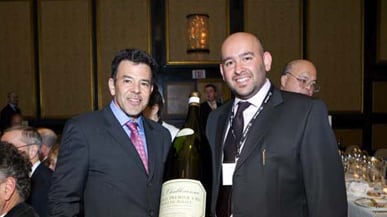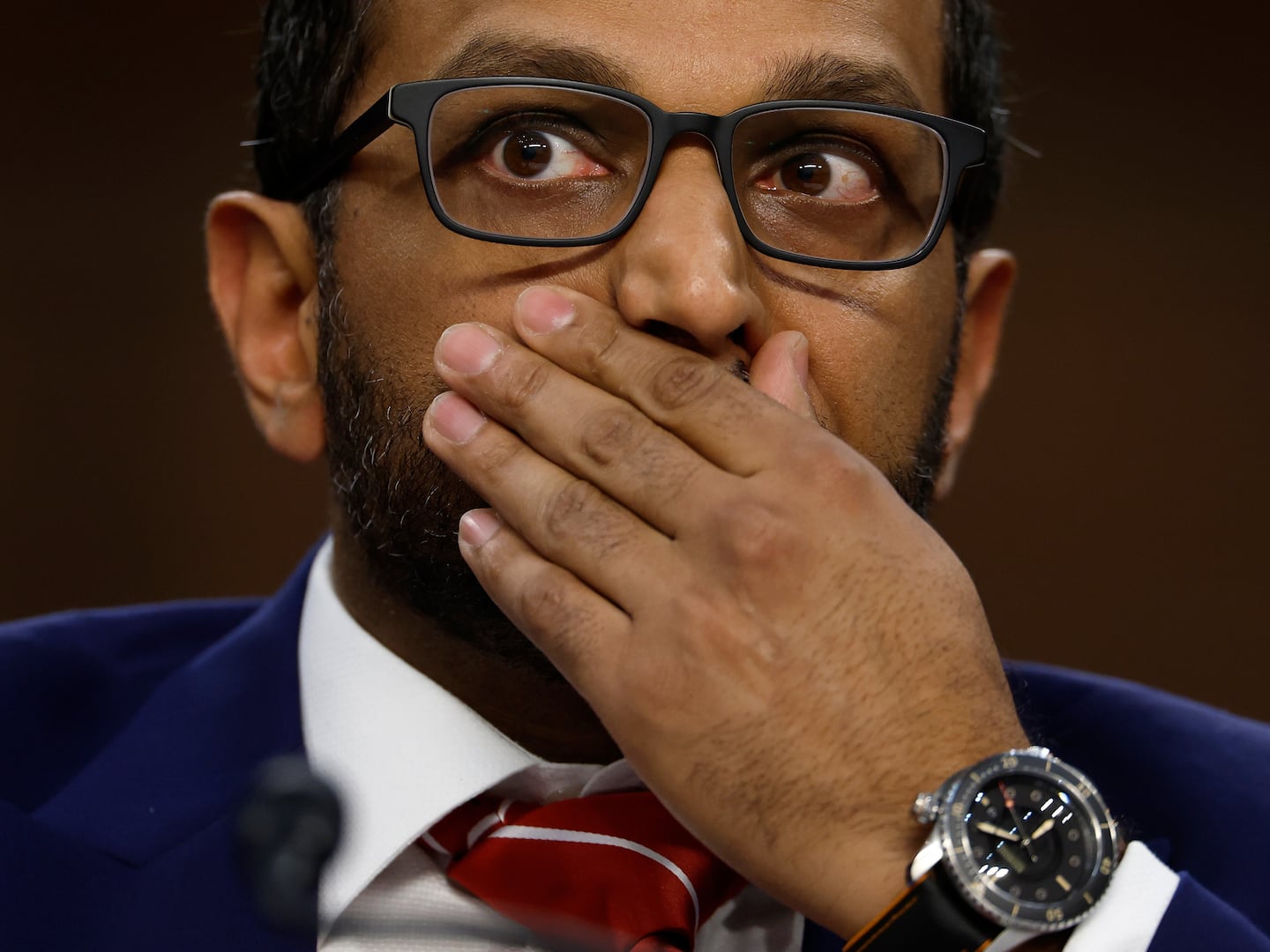Daniel Johnnes' office looks out onto the intersection of West Broadway and Canal Street at the mouth of the Holland Tunnel. Yet for Johnnes, the view is far less important than the gallery of photos on the wall to the right of his desk, where black-and-white headshots of Burgundy’s greatest winemakers peer over his shoulder like patron saints: Christophe Roumier of Domaine Georges Roumier in Chambolle-Musigny; Jean-Marie Fourrier of Domaine Fourrier in Gevry Chambertin; Dominique Lafon of Domaine Comtes Lafon in Meursault; and Frédéric Mugnier of Domaine Jacques-Frédéric Mugnier also in Chambolle-Musigny, to name a few. All have the pensive eyes and deeply etched skin of men who spend their life in the vineyard and the cellar.
Gallery: View Photos of La Pauleé de New York

Johnnes gestures toward his friends. “They’re all coming back this year,” he says. He’s referring to La Paulée de New York, the Burgundy festival he hosts in Manhattan bi-annually, modeled on Les Trois Glorious, an event held in Beaune each year on the third weekend in November, which begins with a banquet hosted by the Confrèrie des Chevaliers du Tastevin, continues with an auction of wines from the Hospices de Beaune and ends with the famed La Paulée de Meursault.
La Paulée de Meursault is a true bacchanal. Winemakers, vineyard owners, and Burgundy connoisseurs from around the globe bring a few bottles of their own wines to Château de Meursault, where they gather at long communal tables for a gala lunch which lasts well into the night. They sing harvest songs and pull cork after cork after cork.
The tradition dates back to the Middle Ages when Cistercian monks invited their vineyard workers to a dinner celebrating the end of the harvest. In fact, the name La Paulée draws from the French word for frying pan, poêle, from which food prepared by the monks was served. Its modern incarnation, created in 1923 by the renowned winemaker Jules Lafon, has become one of the wine world’s most coveted tickets.
In 1993, Johnnes received an invitation from Dominique Lafon, the great-grandson of Jules Lafon, to attend with his wife Sally. The event’s camaraderie, generosity and unabashed joie de vivre overwhelmed him. It was everything he loved about Burgundy, blown up on steroids. He decided, “I have to bring this to New York!”
This year on February 12, 350 people will gather at the Metropolitan Pavilion for the 10th La Paulée de New York Gala Dinner. While the spirit of the event is about sharing without pretension, La Paulée de New York is more about special wines than it is about celebrating the harvest. With over $1 million of wine in the room, it may be the world’s most extravagant BYOB party.
Guests enter the hall and check their coats at the coat check and check their wines with a sommelier. The sommelier puts the guest’s name on a bottle and brings it to the “war room,” where another sommelier places it with the other bottles to be served at the guest’s table.
Over the course of the evening, sommeliers pour each guest 120 wines, four wines from 33 top Burgundy producers, plus their own bottle. A core group of collectors bring very rare wines: a 1992 Le Montrachet, a 1971 Domaine de la Romanée-Conti Richebourg, or a Christophe Roumier Bonne Mares 1998. Mere mortals bring more accessible wines, often sentimental bottles purchased on a trip to Burgundy or on a special occasion. A troupe of traditional Burgundian folk singers, Les Cadets de Bourgogne, lead guests in a variety of traditional harvest songs. Women in cocktail dresses, famous winemakers, celebrity chefs and men in custom suits wave napkins as they sing.
The meal, not to be upstaged, is commandeered by a different chef for each course. “Listening to chefs come up with recipes is always exciting,” says Johnnes. This year Tom Colicchio offers Cauliflower Panna Cotta, Michel Troisgros prepares a Lobster Navrin, Daniel Boulud makes Poularde Demi-Deul, Daniel Humm serves Veal Cheeks with Black Truffles, and finally Daniel Dominique Ansel offers Chocolate and Praline Ganache for dessert.
The price tag for the dinner is exorbitant at $1,400 a person, but for hardcore Burgundy lovers it is worth it. “The great Burgundy producers don’t open their cellars to the public because their bottles are heavily allocated and they would have no wine to sell to those who come to taste. We give people access to great domains and the chance to meet the winemakers and talk about the wines,” Johnnes says, adding, “Wine lovers, especially Burgundy lovers are drawn to that.”
For hard-core Burgundy lovers for whom the price of the dinner is prohibitive there are other events, including an Insider’s Tour of Burgundy with Jasper Morris, MW and Becky Wasserman and a Grand Tasting with winemakers from 33 leading domaines serving four wines each.
Top sommeliers come from all across the United States at their own expense to work the event without pay. Their official role is to help the guests share their wines with one another. But they come for the chance to meet famous producers, taste rare wines and to find camaraderie among colleagues and clients.
Led by David Gordon of the Myriad Group and Bernie Sun of Jean Georges, the list of participating sommeliers reads like a fantasy league team for wine service. It includes Michel Couvreux of Per Se, Paul Grieco of Hearth and Terroir, Michael Madrigale of Bar Boulud, Rajat Parr of Michael Mina, Juliette Pope of Gramercy Tavern, Aldo Sohm of Le Bernardin, and Chad Zeigler of RN 74. Johnnes acts as host, walking the floor with a jéroboam (double magnum) of a Grand Cru such as “Clos des Faively,” the only Grand Cru site to bear the name of its owner.
Johnnes’ ascendance to being New York’s bridge to Burgundy began in 1983. Having just returned from studying in France, he worked as a salesman at the Upper West Side wine store Acker Merrall & Condit under the tutelage of Jerry Jacobson. Back then Acker Merrall was one of the few wine stores that carried all the great domains. Jacobson brought Johnnes with him to Burgundy on a buying trip, during which they went into the cellars and met the winemakers.
“That is when I met Christophe Roumier,” Johnnes points to his wall of pictures. “He had just taken over for his father.”
At that time, Johnnes also worked at the restaurant La Regence. There he met two more men who became instrumental in his professional life, the chef Daniel Boulud and the then captain Drew Nieporent. Johnnes helped Nieporent open Montrachet and went on to become the wine director for Montrachet, Nobu, and Tribeca Grill, Nieporent’s other restaurants.
In 1988, a friend of Johnnes named Phil Stafford came to Montrachet to show him a half bottle of 1917 Richebourg from the cellar of an estate where Stafford was renting a carriage house. The owner wanted to sell the cellar and Stafford asked if Johnnes would assess the collection. At the time, Stafford was in the process of obtaining an import license for a company called USA Wine Imports. Johnnes asked Stafford if he could clear some wines for him to bring in for the restaurant Montrachet. Stafford agreed. Little by little other people wanted to buy Johnnes’ wines, the clientele expanded and the import company Daniel Johnnes Wines was born. Today Michael Skurnick is the exclusive importer for Daniel Johnnes Wines, which includes selections from Alsace, the Loire Valley, the Rhône Valley, Bordeaux, Languedoc Rousillon, and, of course, Burgundy.
“After a week of eating in fine restaurants surrounded by collectors and journalists, they want to let loose. At heart, they are farmers,” [Johnnes] says.
When after September 11, 2001, Tribeca became hauntingly quiet and stayed that way for a while, Daniel Boulud asked Johnnes to help him open Bar Boulud and come on as beverage manager of the Dinex Group. For Johnnes, this was a dream job. He would have another opportunity to work with high-quality professional chefs and assemble a team of top sommeliers. “Daniel has a great appreciation of wine,” says Johnnes, “finer than any chef I know. He understands even great sausages deserve to be paired with fine wine, even if it is in a more rustic style.”
In 2007, not to miss a part of the trade, Johnnes began moonlighting as a winemaker in both Oregon and Burgundy. In Oregon he was mentored by his friend the esteemed winemaker Eric Hamacher and in Burgundy he learned from Frédéric Mugnier, one of the most talented winemakers working today. In 2009, he made a second vintage of wine in Burgundy with grapes from Gevery-Chambertin.
“With the first vintage, I threw away two thirds of the grapes from the sorting table over the course of 12 hours,” he recalls. “I’m very competitive, so when after all that time Fred observed, ‘the grapes are not so pretty,’ we sorted some more.”
Johnnes made two barrels of wine he describes as very light, but expressive of its type with gentle vibrations, high tones and brightness. “What I like is that I know the grapes gave all that they could,” he says. Then, with a sense of awe, he describes how the legendary winemaker Henri Jayer could look at the quality of the grapes at harvest time and imagine the wine they could become. “Jayer is a true artist,” says Johnnes, “a conduit between grapes and wine.”
In the month leading up to La Paulée de New York, Johnnes abstains from alcohol. When the night begins, he will walk the room with his jéroboam and a tasting glass, sampling multiple vintages of his favorite wines: Chambolle-Musigny, which he loves for its elegance, intensity, lightness on the tongue and layers of aroma as it ages and Le Montrachet, which he calls the world’s greatest expression of Chardonnay.
The next morning, when the party is over and the collectors and connoisseurs are home in bed, Johnnes arranges a bike ride for the celebrated winemakers he feels lucky to count among his friends. He takes them on a ride up the West Side through Central Park to Harlem for BBQ, or over the Brooklyn Bridge to Red Hook for coffee and a ferry ride to The Statue of Liberty. This year he is looking for a beer hall in Williamsburg. “After a week of eating in fine restaurants surrounded by collectors and journalists, they want to let loose. At heart, they are farmers,” he says.
Sophie Helene Menin writes about food and wine, sense of place and the pleasures of the table. Her work has appeared in The New York Times, Departures and Saveur, among other publications. She lives in New York City.






